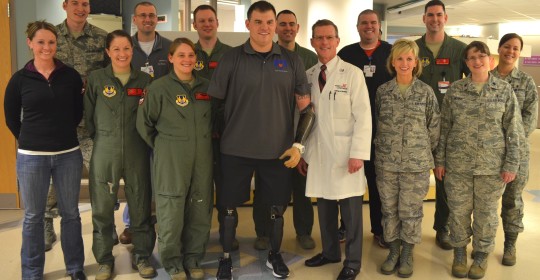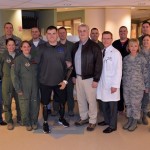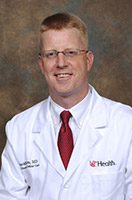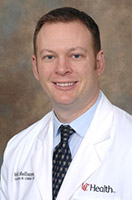
C-STARS Simulation Center Helps U.S. Air Force Medical Personnel Train
The University of Cincinnati Medical Center houses one of only three Centers for the Sustainment of Trauma and Readiness Skills (C-STARS) selected by the U.S. Air Force and is the only such center to focus on air evacuation of critically injured patients. Since its inception in 2002, the C-STARS program has trained personnel to be members of a Critical Care Air Transport Team (CCATT), each of which comprises a physician trained in critical care, a critical-care nurse, and a respiratory therapist. The Air Force CCATT program began after Operation Desert Storm revealed care gaps, reached maturity during the recent conflicts with Iraq and Afghanistan, and has taken on an increasing role in civilian emergency situations.

Sgt. Travis Mills, transported by a CCATT trained by C-STARS, poses with the current cadre of trainees.
“The existence of CCATT programs,” notes assistant professor of clinical medicine David Norton, MD, “has changed the way modern nations approach protracted conflict,” allowing for a shift in focus from a significant forward medical footprint to expert medical care far from the combat zone. C-STARS is a rigorous 2-week session that simulates battle and disaster conditions such as limited visibility and loud noises. The course provides validation, as all participants must pass before deploying to a combat zone. More than 210 medical professionals have participated in this training each year since the program started in 2002, with 14 classes of 15 students each. Dr. Norton emphasizes that the C-STARS program represents a functioning collaborative venture between the military and civilian medical populations.
“Where CCATT goes from here is an interesting question,” says Mehdi Shelhamer, DO, C-STARS cadre and instructor of clinical medicine with the division of pulmonary and critical care medicine. “The need will always exist, but as the military mission of the U.S. downsizes, CCATT teams are transitioning to peacetime disaster relief work. Often, this means patients are more likely to have medical critical care issues than the trauma-related injuries seen on battlefields.” It can be difficult to maintain preparedness in the peacetime setting, but this is accomplished with a combination of a high fidelity simulation center and hands-on patient care. And when a team is intubating a civilian or military patient at 35,000 feet, during a 17-hour flight in near-darkness with instruments buffeted by turbulence, intensive training is indeed critical.
 David Norton, MD
David Norton, MD
Assistant Professor of Clinical Medicine
Director, Medical Intensive Care Unit
Division of Pulmonary and Critical Care Medicine
(513) 558-4831
nortondi@UCMAIL.UC.EDU
 Mehdi Shelhamer, DO
Mehdi Shelhamer, DO
Major, USAF, MC
Cadre, C-STARS Cincinnati
Volunteer Instructor of Clinical Medicine
Division of Pulmonary and Critical Care Medicine
(513) 584-0331
SHELHAMI@ucmail.uc.edu

